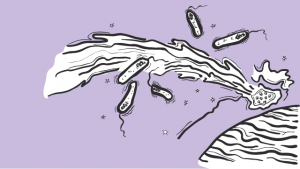Life is fragile; at least, that is what experience tells us. As far as we know, Earth is the only planet in the Universe to support life despite being threatened by a multitude of dangers, from nuclear radiation to climate change. However, a few organisms are significantly less delicate. They can survive the most inhospitable of environments, including temperatures close to absolute zero and levels of UV radiation hundreds of times higher than we can. These organisms are known as extremophiles and exemplify the power of single celled organisms, as detailed in the Michaelmas 2010 issue of Bang!. The robustness of these microbes has proved important in the development of biotechnology and may even provide the key to life beyond the Earth.
An important extremophile is the enzyme Taq polymerase, which can withstand very high temperatures and has revolutionised the study of genetics. Due to the minute amount of DNA in each cell, early geneticists frequently had problems producing enough of it to study. In order to replicate DNA, a process known as polymerase chain reaction was developed. First, the double-stranded helix is split at high temperature and then a DNA replicating enzyme is used to duplicate it. The problem was that none of the replicating enzymes worked at the temperatures required to split the strands. When Taq polymerase, which could survive such temperatures, was isolated from T.aquaticus, geneticists finally had the tool they needed. This enzyme, and others similar to it, are now used in the majority of genetic research.
Another bacterium, Deinococcus radiodurans, may prove to be important in future biotechnology. The discovery of this extremophile was rather unusual. Researchers who were attempting to develop a method of sterilising canned food by exposing it to radiation noticed that the food still went off, even with extremely high doses. The cause was D.radiodurans, which had survived the radiation. Since then, researchers have discovered that this bacterium can withstand dosages of radiation a thousand times the limit that humans can endure.
Many potential uses of this microbe have been suggested, including the transformation of mercury into a less toxic form in radioactive waste. A more novel idea is to use it as a means of storing important information in case of a nuclear holocaust. Scientists coded the song ‘It’s A Small World’ by the Sherman Brothers into a sequence of artificial DNA, which was then transferred to the genetic sequence of D.radiodurans. The message was transferred from parent to offspring, creating a population of bacteria with the song encoded in their DNA, thereby safeguarding it over time.
The ability of D.radiodurans to survive radiation is so exceptional that a group of Russian and American scientists proposed that the species must have an extraterrestrial origin. As its capacity to survive radiation far exceeds conditions on Earth, they suggested that the bacterium must have evolved somewhere where radiation is much higher, such as Mars. There are major doubts over this idea, but even if it is proven false, this bacterium may one day undergo space travel anyway: a genetically modified strain that generates medicines or recycles waste would be a huge advantage for space explorers or settlers.
The possibility that organisms can survive in space has implications for current theories on whether life exists elsewhere in the universe, as well as the orgins of life on Earth. If some creatures can survive for long periods in space, then life may be able to travel from planet to planet on asteroids. Through such planet hopping, an extremophile may have originally seeded life on Earth.
Extremophiles suggest that life could flourish on other planets in conditions that are less amenable than those on Earth. In the past, life has endured supervolcanoes and asteroid collisions, and come back stronger than ever. Extremophiles, the most obstinate survivors, have provided us with useful biotechnology and challenged our concept of just what life is capable of living through. With increasing risks to Earth’s more fragile inhabitants, extremophiles may hold the key to helping them survive.
Jeremy Brown is a 2nd year undergraduate studying Biological Sciences at Queen’s College.
Art by Anna Pouncey.
![On the Edge Life is fragile; at least, that is what experience tells us. As far as we know, Earth is the only planet in the Universe to […]](/wp-content/uploads/2011/10/on-the-edge_preview-620x300.png)
